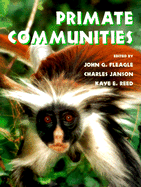Book contents
- Frontmatter
- Contents
- List of contributors
- Preface
- 1 African primate communities: Determinants of structure and threats to survival
- 2 Biomass and use of resources in south and south-east Asian primate communities
- 3 Species coexistence, distribution, and environmental determinants of neotropical primate richness: A community-level zoogeographic analysis
- 4 Primate communities: Madagascar
- 5 Primate diversity
- 6 Phylogenetic and temporal perspectives on primate ecology
- 7 Population density of primates in communities: Differences in community structure
- 8 Body mass, competition and the structure of primate communities
- 9 Convergence and divergence in primate social systems
- 10 Of mice and monkeys: Primates as predictors of mammal community richness
- 11 Comparing communities
- 12 Large-scale patterns of species richness and species range size in anthropoid primates
- 13 The recent evolutionary past of primate communities: Likely environmental impacts during the past three millennia
- 14 Resources and primate community structure
- 15 Effects of subsistence hunting and forest types on the structure of Amazonian primate communities
- 16 Spatial and temporal scales in primate community structure
- 17 Primate communities in Africa: The consequences of long-term evolution or the artifact of recent hunting?
- 18 The future of primate communities: A reflection of the present?
- 19 Concluding remarks
- Systematic index
- Subject index
18 - The future of primate communities: A reflection of the present?
Published online by Cambridge University Press: 21 August 2009
- Frontmatter
- Contents
- List of contributors
- Preface
- 1 African primate communities: Determinants of structure and threats to survival
- 2 Biomass and use of resources in south and south-east Asian primate communities
- 3 Species coexistence, distribution, and environmental determinants of neotropical primate richness: A community-level zoogeographic analysis
- 4 Primate communities: Madagascar
- 5 Primate diversity
- 6 Phylogenetic and temporal perspectives on primate ecology
- 7 Population density of primates in communities: Differences in community structure
- 8 Body mass, competition and the structure of primate communities
- 9 Convergence and divergence in primate social systems
- 10 Of mice and monkeys: Primates as predictors of mammal community richness
- 11 Comparing communities
- 12 Large-scale patterns of species richness and species range size in anthropoid primates
- 13 The recent evolutionary past of primate communities: Likely environmental impacts during the past three millennia
- 14 Resources and primate community structure
- 15 Effects of subsistence hunting and forest types on the structure of Amazonian primate communities
- 16 Spatial and temporal scales in primate community structure
- 17 Primate communities in Africa: The consequences of long-term evolution or the artifact of recent hunting?
- 18 The future of primate communities: A reflection of the present?
- 19 Concluding remarks
- Systematic index
- Subject index
Summary
INTRODUCTION
In widely different habitats and among taxonomically diverse groups, recent extinction rates are 100–1000 times their pre-human levels, with regions rich in endemics especially at risk (Wilson, 1988; Pimm et al., 1995). There is a strong recognition that many primate species are in jeopardy of extinction in the near future (Mittermeier, 1988; Rowe, 1996). Half of the 250 primate species are considered to be of conservation concern according to the Primate Specialist Group of the Species Survival Commission of the World Conservation Union (IUCN, 1996). It is an achievement for primate conservationists that we have not lost any species in this millennium, as other groups such as rodents, birds and reptiles have (Mittermeier, 1996). And primatologists should be congratulated that within the last decade more than 15 new primate species have been discovered or rediscovered (Meier et al., 1987; Simons, 1988; Hershkovitz, 1987, 1990; Meier & Albignac, 1991; Mittermeier et al., 1992; Ferrari & Lopes, 1992; Queiroz, 1992; Silva & Noronha, in press). But it is a sobering fact that 96 primate species are in the Critically Endangered or Endangered category and could disappear within the next 100 years (Rowe, 1996).
The inventory data and categories of threat developed by the Conservation Monitoring Center (IUCN) and The United States Endangered Species Act (USESA), (World Conservation Monitoring Centre, 1992; Rowe, 1996) are very useful in targeting primate species with high conservation priority. But the lists of endangered species alone have limited use in estimating causes and consequences of primate extinctions. Indeed, a major limitation of species counting in conservation biology is that ecological measures of biodiversity are not reducible to taxonomic measures (e.g., Fig. 18.1, Jernvall & Wright, 1998).
- Type
- Chapter
- Information
- Primate Communities , pp. 295 - 309Publisher: Cambridge University PressPrint publication year: 1999
- 10
- Cited by



